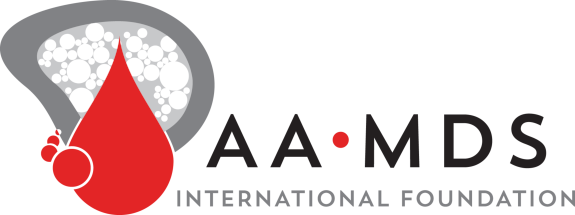Growth factors are naturally occurring hormones in your body that signal your bone marrow bone marrow: The soft, spongy tissue inside most bones. Blood cells are formed in the bone marrow. to make more of certain types of blood cells. Man-made growth factors may be given to some people with bone marrow failure bone marrow failure: A condition that occurs when the bone marrow stops making enough healthy blood cells. The most common of these rare diseases are aplastic anemia, myelodysplastic syndromes (MDS) and paroxysmal nocturnal hemoglobinuria (PNH). Bone marrow failure can be acquired (begin any time in life) or can be… diseases to help increase red blood cell red blood cell: The most numerous type of blood cell in healthy people. Red blood cells contain hemoglobin, a protein that picks up oxygen in the lungs and brings it to cells in all parts of the body. Also called erythrocyte, RBC. , white blood cell white blood cell: Cells in the body that fight disease and infection by attacking and killing germs. There are several types of white blood cells including neutrophils, eosinophils, basophils, lymphocytes and monocytes. Each type of cell fights a different kind of germ. Also called WBC, leukocyte. or platelet platelet: The smallest type of blood cell. Platelets help the blood to clot and stop bleeding. Also called a thrombocyte. counts.
Red Cell Growth Factor
Red cell growth factor growth factor: A substance made by the body that stimulates the bone marrow to produce blood cells. Some growth factors are man-made in the laboratory and used for treating low blood counts. These include red blood cell growth factors called erythropoietin (EPO) and darbepoetin, and white blood cell growth… is called erythropoietin erythropoietin: (i-rith-row-POY-uh-tun) A protein made by the kidneys. Erythropoietin, also called EPO, is created in response to low oxygen levels in the body (anemia). EPO causes the bone marrow to make more red blood cells. A shortage of EPO can also cause anemia. or EPO for short. It is a hormone hormone: A part of the endocrine system that serves as the body's chemical messengers. Hormones move through the bloodstream to transfer information and instruction from one set of cells to another. naturally produced in the kidneys. Your kidneys make more EPO in response to low levels of oxygen in your body. Man-made forms of EPO are called erythropoiesis-stimulating agents, or ESAs for short. These may be given to people with bone marrow failure diseases to reduce the need for red blood cell transfusions.
There are two types of man-made EPO:
- Epoetin alpha comes in the brand names Epogen® and Procrit®.
- Darbapoietin comes in the brand name Aranesp®.
Epoetin alpha and Darbapoietin are usually given as an injection (shot) under the skin. They may also be given as an infusion into a vein through an intravenous IV. You may also be trained to give these to yourself at home.
Red cell growth factors work by signaling your bone marrow stem cells stem cells: Cells in the body that develop into other cells. There are two main sources of stem cells. Embryonic stem cells come from human embryos and are used in medical research. Adult stem cells in the body repair and maintain the organ or tissue in which they are found. Blood-forming (hemapoietic) stem… to make more red blood cells. It may take between 2 and 6 weeks for them to work.
How well do they work?
Red cell growth factors are often prescribed for MDS patients. How well they work varies a lot from patient to patient and is dependent on many factors. They are not right for all MDS patients. Studies suggest that as many as 6 in 10 MDS patients will see some improvement in blood counts from these drugs.
Red cell growth factors are not effective in people with severe or very severe aplastic anemia aplastic anemia: (ay-PLASS-tik uh-NEE_mee-uh) A rare and serious condition in which the bone marrow fails to make enough blood cells - red blood cells, white blood cells, and platelets. The term aplastic is a Greek word meaning not to form. Anemia is a condition that happens when red blood cell count is low. Most… because there are too few stem cells in the bone marrow to stimulate. They may be used after immunosuppressive therapy immunosuppressive therapy: Immunosuppressive drug therapy lowers your body's immune response. This prevents your immune system from attacking your bone marrow, allowing bone marrow stem cells to grow, which raises blood counts. For older patients with acquired aplastic anemia, immunosuppressive drug therapy is the… is done and bone marrow stem cells start to come back.
What are common side effects?
Some of the more common side effects of red cell growth factors include:
- Joint, muscle or bone pain
- Headache
- Dizziness
- Fever
- Cough
- Nausea
- Vomiting
- Diarrhea or constipation
- iItching
- Redness and pain in the skin where the shot was given
White Cell Growth Factor
If you don't have enough healthy white cells in your blood, your doctor may ask you to take a man-made white blood cell growth factor to help you fight infection. There are two types of white cell growth factor:
- Granulocyte Granulocyte: Any one of these three types of white blood cells - neutrophils, eosinophils, and basophils. These cells have granules that contain enzymes to help fight infection. colony-stimulating factor (G-CSF) is sold under the names Filgrastim® and Neupogen®. G-CSF is typically given as an injection (shot) under the skin or an infusion into a vein once per day.
- Granulocyte macrophage colony-stimulating factor (GM-CSF) is sold under the names Leukine® and Sargramostim®. GM-CSF is typically given as an injection (shot) under the skin or as an IV infusion drip.
How well do they work?
Doctors are careful about giving white cell growth factors to MDS patients. Sometimes, white cell growth factors can increase the growth of blast cells in patients with high-risk MDS. This can be a serious problem. For this reason, the use of these growth factors for MDS patients is often limited to the treatment of infections, along with antibiotics antibiotics: The most common white blood cells are called neutrophils. They fight infection. Patients who don't have enough healthy neutrophils are said to have neutropenia. Because of their low white count, they may get infections easily and have trouble getting rid of infections. If you have neutropenia,… .
What are common side effects?
Some of the more common side effects of white cell growth factors include:
- Redness, swelling, bruising, itching or a lump at the injection site
- Bone, joint or muscle pain
- Headache
- Fever
- Diarrhea
- Skin rash
- Weakness
- Dizziness
Platelet Growth Factor
Platelet growth factor is called thrombopoietin. It is a hormone produced by the liver and kidney which stimulates the production of platelets. There are two man-made platelet growth factors available to treat bone marrow failure diseases. These include:
- Eltrombopag Eltrombopag: What are the possible side effects of eltrombopag (Promacta)? Get emergency medical help if you have any of these signs of an allergic reaction: hives; difficult breathing; swelling of your face, lips, tongue, or throat. Stop using eltrombopag and call your doctor at once if you have: … (Promacta ®) is approved to treat aplastic anemia. It comes as a tablet and as a powder for oral suspension (liquid) to take by mouth.
- Romiplostim Romiplostim: Romiplostim is in a class of medications called thrombopoietin receptor agonists. It works by causing the cells in the bone marrow to produce more platelets. Romiplostim injection is used to increase the number of platelets enough to lower the risk of bleeding, but it is not used to increase the… (NPlaste ®) is currently approved only to treat low platelet counts caused by a disease called immune thrombocytopenia thrombocytopenia: (throm-buh-sie-tuh-PEE-nee-uh) A condition in which there is a shortage of platelets in the bloodstream. This results in a low platelet count. Bleeding and bruising often occur with thrombocytopenia. (ITP). Initial studies show that it can increase blast counts on MDS patients, so it is not recommended for MDS patients at this time. It is given as an injection (shot) under the skin in a doctor’s office or hospital.
How well do they work?
A study was done giving eltrombopag to patients with acquired aplastic anemia who did not respond to standard immunosuppressive therapy with ATG and cyclosporine cyclosporine: Cyclosporine is used along with antithymocyte globulin (ATG), another immunosuppressant, for treating aplastic anemia and some other forms of bone marrow failure. . This study found that about 4 in 10 patients given eltrombopag had an increase in platelets, as well as red cells and white cells.
Research is underway to see how eltrombopag works when given earlier in the treatment process, along with immunosuppressive therapy using ATG and cyclosporine.
What are the common side effects?
Some of the common side effects of platelet growth factors include:
- Nausea and dizziness
- Feeling tired and shortness of breath
- Cough and runny nose
- Diarrhea and stomach pain
- Headache
- Pain in arms, legs, hands or feet
- Fever
- Pain in the nose or throat
- Bruising
- Muscle spasms
- Joint pain


